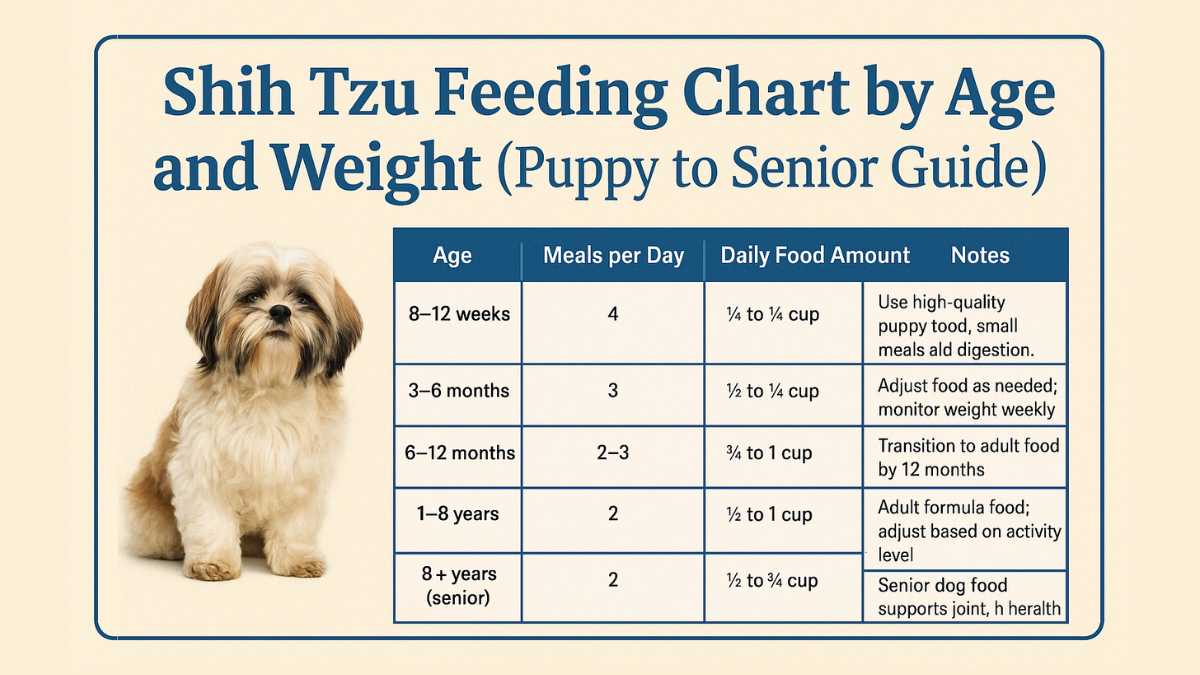Shih Tzu Feeding Chart by Age and Weight (Puppy to Senior Guide)

Feeding a Shih Tzu properly isn’t just a daily routine; it’s a commitment to their health, energy, and overall happiness. These small, affectionate dogs have specific dietary needs that change as they grow. A well-structured feeding chart that considers both age and weight can help pet owners navigate these needs with confidence.
What is a Shih Tzu Feeding Chart by Age?
A Shih Tzu feeding chart by age is a practical reference that outlines how much and how often you should feed your dog as they transition from puppyhood to adulthood and eventually into their senior years. This chart is not one-size-fits-all; it is carefully calibrated based on age, weight, metabolism, and activity levels. Puppies, adults, and senior dogs all have very different nutritional demands, and a chart ensures you’re meeting them appropriately.
Why It Matters
The Shih Tzu is a toy breed with a compact frame and sensitive digestive system. Feeding too much can lead to obesity and joint problems, while too little can result in nutrient deficiencies and stunted development. By following a feeding chart, you help support steady growth, maintain energy levels, and reduce the risk of long-term health issues.
Benefits of Following a Feeding Chart
A structured feeding chart brings multiple benefits to both the owner and the dog. First, it ensures your pet gets the right nutrients at the right time. Second, it simplifies portion control and meal timing, reducing the chances of overfeeding or underfeeding. Third, it creates a predictable routine that your Shih Tzu will appreciate, leading to better digestion and less anxiety around food.
Feeding Guide for Shih Tzu Puppies
Shih Tzu puppies require more frequent meals due to their high energy and rapid development. From 8 to 12 weeks old, they should be fed four times a day with high-quality puppy food rich in protein and fat. At this age, their meals should total about 1/4 to 1/2 cup per day. Between 3 to 6 months, the meal frequency can be reduced to three times a day, with portion sizes increasing slightly. From 6 to 12 months, two to three meals per day is usually sufficient, with up to 3/4 cup or more depending on weight and activity.
Feeding Adult Shih Tzus
From 1 to 8 years old, a Shih Tzu enters adulthood and stabilizes in weight and activity. At this stage, feeding twice a day is ideal. The amount can range from 1/2 to 1 cup per day. Dogs on the higher end of the weight spectrum or with more active lifestyles may require closer to 1 cup, while less active or smaller dogs will need less. High-quality adult dog food, balanced with protein, fat, and carbohydrates, should be used.
Feeding for Senior Shih Tzus
Once a Shih Tzu hits the 8-year mark, their metabolism begins to slow, and its dietary needs shift. Senior dogs still need nutrients, but in lower quantities. They are prone to weight gain, joint issues, and heart conditions. Feeding should continue twice a day, but total food intake should be adjusted to about 1/2 to 3/4 cup daily, depending on their health and mobility. A senior-specific dog food formula, often with added glucosamine and reduced fat, is highly recommended.
Feeding Chart by Weight
A complementary way to refine your Shih Tzu’s diet is by considering weight. Here is a general guideline:
- 5 lbs: 1/4 to 1/3 cup
- 8 lbs: 1/3 to 1/2 cup
- 10 lbs: 1/2 to 2/3 cup
- 14 lbs: 2/3 to 3/4 cup
- 16 lbs: 3/4 to 1 cup
Keep in mind, this can vary based on activity levels and health. These figures are based on dry food and can differ for wet or homemade meals.
Dry vs Wet Food
Dry kibble is beneficial for dental health and portion control. It has a longer shelf life and is generally more economical. Wet food, on the other hand, offers moisture, which can be helpful for hydration and appeal. For picky eaters or older dogs with dental issues, wet food can be a better option. Many owners opt to combine both, mixing wet food with dry kibble for a balanced approach.
How to Transition Between Life Stages
Transitioning your Shih Tzu’s diet from one life stage to another should be done gradually over a week. Mix increasing amounts of the new food with the current one to allow the digestive system to adjust. Look for signs of intolerance like loose stool, vomiting, or lethargy, and consult your vet if issues persist.
Feeding Mistakes to Avoid
Common mistakes include feeding table scraps, free-feeding without measured portions, giving too many treats, or skipping meals. These habits can lead to digestive upset, behavioral issues, and weight gain. Always use a measuring cup and stick to a schedule.
Tips for Healthy Feeding Habits
- Feed at the same times daily to establish a routine.
- Use a slow-feeder bowl to prevent gulping.
- Offer fresh water at all times.
- Limit treats to 10% of daily calorie intake.
- Weigh your dog monthly to track changes.
Sample Daily Meal Plans
- Puppy (8–12 weeks): 1/2 cup divided into 4 meals
- Adult (5–10 lbs): 3/4 cup divided into 2 meals
- Senior (10–14 lbs): 2/3 cup divided into 2 meals, plus joint supplements
Quick Feeding Reference Table
| Age | Meals/Day | Total Food (Dry) |
|---|---|---|
| 8–12 weeks | 4 | 1/4 to 1/2 cup |
| 3–6 months | 3 | 1/2 to 3/4 cup |
| 6–12 months | 2–3 | 3/4 to 1 cup |
| 1–8 years | 2 | 1/2 to 1 cup |
| 8+ years | 2 | 1/2 to 3/4 cup |
Conclusion
Feeding your Shih Tzu isn’t about guesswork; it’s a thoughtful process that evolves with age and weight. A feeding chart by age and weight helps you stay ahead of dietary needs, supports health, and creates a nurturing bond with your pet. Whether you’re raising a bubbly puppy or caring for a gentle senior, being intentional with their meals ensures they live their happiest and healthiest life.
Feed smart, love deeper—tailor your Shih Tzu’s meals by age and weight for a lifetime of wellness.




